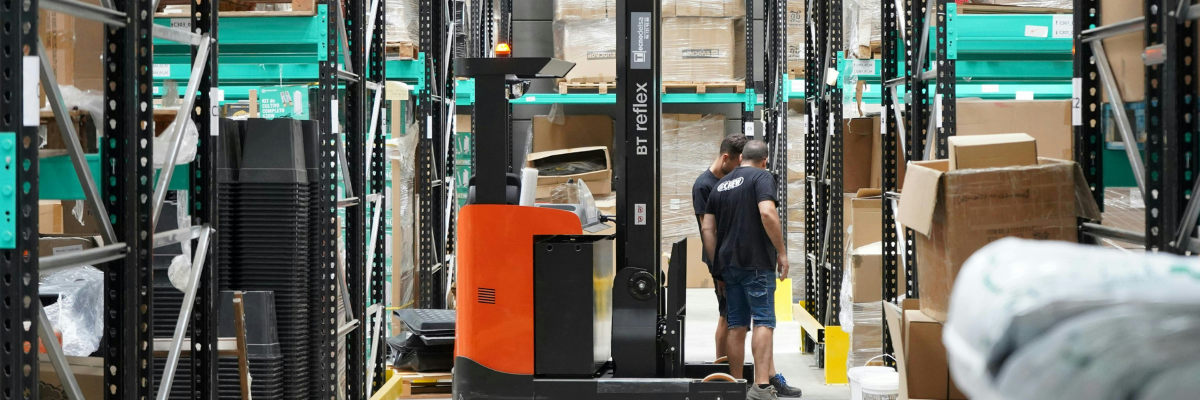Efficient logistics and warehouse management is no longer just a competitive advantage: it is a necessity. Consumers expect fast delivery, real-time availability and smooth processes. However, many companies are faced with complex challenges in terms of organization, traceability and optimization of resources.
In this article, we’ll explore how to tackle the main challenges associated with logistics and warehouse management, what objectives to pursue, and how a solution like Hubrise can help you turn these aspects into strategic levers for growing your business.

What is meant by logistics and warehouse management?
Logistics and warehouse management includes the entire operational flow that enables a product to move from the supplier to the end customer in the shortest possible time and with the highest level of efficiency. This includes activities such as procurement, goods receipt, storage, the picking and packing and finally shipping.
Optimizing these aspects, especially through advanced order fulfillment strategies, is essential to improve order processing times and deliver a service that meets customer expectations.
What is the objective of logistics?
The purpose of logistics is to ensure that every product reaches the right customer, at the right time, and under the best economic conditions. Achieving this means precisely coordinating timing, resources, and information across the entire supply chain.
A well-structured logistics not only lowers operating costs, but improves the purchasing experience and strengthens the company’s competitiveness on the market.
What is meant by warehouse management?
Warehouse Management involves all the activities required to organize, control and optimize the internal flow of goods. It means ensuring that each product is correctly registered, positioned and ready to be picked and shipped at the right time. The operations involved include inventory, stock management, movement tracking and stock rotation.
Effective management makes it possible to:
- Optimize available space, reducing waste and handling times;
- Automate processes, minimizing manual errors and speeding up daily operations;
- Prevent stock overages and stock-outs, maintaining a dynamic balance between demand and availability.
Adopting a warehouse management system not only enables the digitization of all these activities but also allows their integration with external logistics, improving the entire order fulfillment cycle.
Discover how to improve order fulfillment times
Challenges in order logistics
Order logistics is now one of the most critical aspects of the entire value chain. Companies find themselves managing an increasing amount of orders, often with 24/48h delivery expectations, especially in the most competitive sectors. Added to these pressures is the need to provide constant and real-time updates on the status of the order, which requires cutting-edge technological and organizational infrastructures .
Among the main challenges to address are:
- Increased volumes: during peak periods (such as Black Friday or Christmas), operational capacity must be scalable to avoid delays and bottlenecks.
- Real-time stock management: it is essential to know exactly which products are available and where, to avoid overselling or shipping delays.
- Human error: manual operations in picking or packing can lead to mistakes, impacting customer satisfaction and increasing return costs.
- Integration between sales channels: with the rise of omnichannel retail, it is crucial that the logistics system be synchronized with e-commerce platforms, physical stores, and marketplaces.
- Customer expectations: fast delivery times and accurate tracking are now required standards, no longer optional extras.

How to best manage the warehouse?
Effective warehouse management is the starting point for ensuring a smooth and uninterrupted supply chain. Relying on Excel spreadsheets or manual processes is no longer sufficient: the complexity of operations, integration with multiple sales channels, and the need to deliver a flawless purchasing experience make the adoption of intelligent systems, capable of monitoring every single product movement in real time, indispensable.
Managing the warehouse effectively means having full control over inflows and outflows, minimizing human errors, optimizing space, and anticipating reorder needs in advance. This is where an advanced warehouse management system comes into play: a valuable ally for enhancing operational efficiency, control, and scalability.
The importance of a warehouse management system
Implementing a modern, integrated warehouse management program is a strategic choice for any company aiming to grow in the world of e-commerce and retail. Automating workflows allows you to reduce operational times, improve order accuracy, and minimize errors, especially during the picking and shipping stages.
An effective system also helps optimize available space, ensure proper stock rotation, and maintain precise control over every movement, from receipt to shipment.
Discover how optimize
stock and logistics
Hubrise: the complete solution for logistics and warehouse management
Thanks to Hubrise, you can synchronize orders, inventories, catalogs and customer data in real time, improving inventory management, logistics efficiency and alignment between departments and sales channels. This approach reduces operational errors, speeds up processes and allows you to offer a more precise, reactive and personalized service.
Centralized integration
Hubrise enables you to easily connect all company systems, fostering continuous and reliable data exchange. This approach eliminates inefficiencies caused by information silos and allows for smoother, more coordinated management of operations across different channels and departments.
Traceability and automation
Thanks to automatic synchronization between applications, Hubrise ensures an always up-to-date view of orders, inventory, and shipments. Information travels in real time between connected systems, improving process traceability and reducing manual errors.
Scalability and flexibility
Hubrise’s approach is designed to grow with your business: whether you manage a single retail location or a complex network, you can integrate new tools and partners without overhauling the entire ecosystem. The result is an agile, stable solution ready to adapt to any business evolution.
Efficiently managing logistics and warehousing is essential to stay competitive. With Hubrise, you can streamline processes, reduce errors, and enhance the customer experience by integrating all your systems into a single solution.